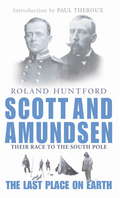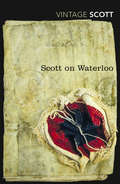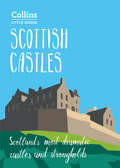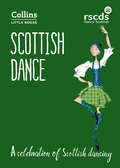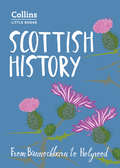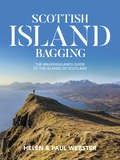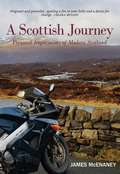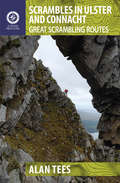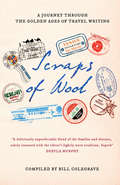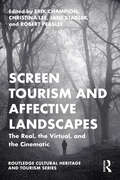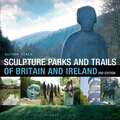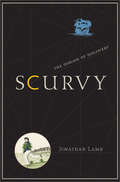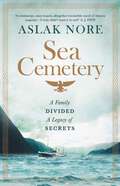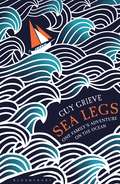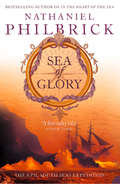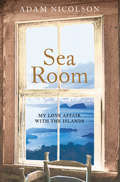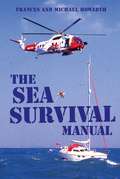- Table View
- List View
Scott And Amundsen: The Last Place on Earth (Exploration Ser.)
by Roland HuntfordAt the beginning of the twentieth century, the South Pole was the most coveted prize in the fiercely nationalistic modern age of exploration. In the brilliant dual biography, the award-winning writer Roland Huntford re-examines every detail of the great race to the South Pole between Britain's Robert Scott and Norway's Roald Amundsen. Scott, who dies along with four of his men only eleven miles from his next cache of supplies, became Britain's beloved failure, while Amundsen, who not only beat Scott to the Pole but returned alive, was largely forgotten. This account of their race is a gripping, highly readable history that captures the driving ambitions of the era and the complex, often deeply flawed men who were charged with carrying them out.THE LAST PLACE ON EARTH is the first of Huntford's masterly trilogy of polar biographies. It is also the only work on the subject in the English language based on the original Norwegian sources, to which Huntford returned to revise and update this edition.
Scott on Waterloo (Virago Modern Classics)
by Sir Walter Scott Paul O'KeeffeOn the 200th anniversary of the Battle of Waterloo discover a fascinating primary source: Walter Scott's accounts of his journey to the battlefieldIn the immediate aftermath of the Battle of Waterloo tourists flocked from Britain to witness the scene of the most important conflict of their generation. Walter Scott was among them, and with a commission from his publisher for a travel book and a long poem. These prose and verse accounts bring to vivid life the carnage, spectacle and excitement of a fascinating period of European history. Brilliantly introduced and annotated by Paul O'Keeffe, this edition elucidates and contextualises Scott's first-hand account of his travels, his dashing epic, ‘The Field of Waterloo’ and the eerily chilling 'Dance of Death'.
Scottish Aviation Jetstream - Twin-engined Pilot Trainer (large print)
by RnibThis is an image of an aircraft seen from above. There is a locator dot shown, which will be at the top left of the page when the image is the correct way up. The image is in the centre and a scale in metres on the left of the page. The aircraft's nose is in the top centre and the tail in the bottom centre of the page. The fuselage goes up and down the middle of the page. The cockpit is shown as a curved window near the nose. The wings go out to the left and right. Sticking out from the front edge of each wing there is an engine with a propeller to the left and right of the fuselage. The bottom edge of the wing has three flaps on each side and the tail wing has one flap on each side. These are the ailerons used to manoeuvre the aircraft when it is flying. The tailplane has a long vertical tail which starts to rise from the fuselage just down from the centre of the image. The tail wing sticks out from the vertical tail halfway up it. The tips of the main wings and the leading half of the tailplane are red. The upper half of the fuselage is red, apart from the nose only a small part of this can be seen. The roof is white. The textures on the tactile image reflect structure not colour. There is a different texture for cockpit, wings, fuselage and engine.
Scottish Aviation Jetstream - Twin-engined Pilot Trainer (UEB contracted)
by RnibThis is an image of an aircraft seen from above. There is a locator dot shown, which will be at the top left of the page when the image is the correct way up. The image is in the centre and a scale in metres on the left of the page. The aircraft's nose is in the top centre and the tail in the bottom centre of the page. The fuselage goes up and down the middle of the page. The cockpit is shown as a curved window near the nose. The wings go out to the left and right. Sticking out from the front edge of each wing there is an engine with a propeller to the left and right of the fuselage. The bottom edge of the wing has three flaps on each side and the tail wing has one flap on each side. These are the ailerons used to manoeuvre the aircraft when it is flying. The tailplane has a long vertical tail which starts to rise from the fuselage just down from the centre of the image. The tail wing sticks out from the vertical tail halfway up it. The tips of the main wings and the leading half of the tailplane are red. The upper half of the fuselage is red, apart from the nose only a small part of this can be seen. The roof is white. The textures on the tactile image reflect structure not colour. There is a different texture for cockpit, wings, fuselage and engine.
Scottish Aviation Jetstream - Twin-engined Pilot Trainer (UEB uncontracted)
by RnibThis is an image of an aircraft seen from above. There is a locator dot shown, which will be at the top left of the page when the image is the correct way up. The image is in the centre and a scale in metres on the left of the page. The aircraft's nose is in the top centre and the tail in the bottom centre of the page. The fuselage goes up and down the middle of the page. The cockpit is shown as a curved window near the nose. The wings go out to the left and right. Sticking out from the front edge of each wing there is an engine with a propeller to the left and right of the fuselage. The bottom edge of the wing has three flaps on each side and the tail wing has one flap on each side. These are the ailerons used to manoeuvre the aircraft when it is flying. The tailplane has a long vertical tail which starts to rise from the fuselage just down from the centre of the image. The tail wing sticks out from the vertical tail halfway up it. The tips of the main wings and the leading half of the tailplane are red. The upper half of the fuselage is red, apart from the nose only a small part of this can be seen. The roof is white. The textures on the tactile image reflect structure not colour. There is a different texture for cockpit, wings, fuselage and engine.
Scottish Aviation Twin Pioneer- STOL Tactical Light Transport (large print)
by RnibThis is an image of an aircraft seen from above. There is a locator dot shown, which will be at the top left of the page when the image is the correct way up. The image is in the centre and a scale in metres on the left of the page. The aircraft's nose is in the top centre and the tail in the bottom centre of the page. The fuselage goes up and down the middle of the page. The cockpit is shown as two small windows near the nose. The wings go out to the left and right. Sticking out from the front edge of each wing is an engine with propellers, to the left and right of the fuselage. The bottom edge of the wing has three flaps on each side and the tail wing has one flap on each side. These are the ailerons used to manoeuvre the aircraft when it is flying. The tailplane has three vertical tails, one in the middle and one to either side. The tips of the main wings and the leading half of the tailplane are red. The upper half of the fuselage is red, apart from the nose only a small part of this can be seen. The roof is white. The textures on the tactile image reflect structure not colour. There is a different texture for the cockpit, wings, fuselage and engine.
Scottish Aviation Twin Pioneer- STOL Tactical Light Transport (UEB contracted)
by RnibThis is an image of an aircraft seen from above. There is a locator dot shown, which will be at the top left of the page when the image is the correct way up. The image is in the centre and a scale in metres on the left of the page. The aircraft's nose is in the top centre and the tail in the bottom centre of the page. The fuselage goes up and down the middle of the page. The cockpit is shown as two small windows near the nose. The wings go out to the left and right. Sticking out from the front edge of each wing is an engine with propellers, to the left and right of the fuselage. The bottom edge of the wing has three flaps on each side and the tail wing has one flap on each side. These are the ailerons used to manoeuvre the aircraft when it is flying. The tailplane has three vertical tails, one in the middle and one to either side. The tips of the main wings and the leading half of the tailplane are red. The upper half of the fuselage is red, apart from the nose only a small part of this can be seen. The roof is white. The textures on the tactile image reflect structure not colour. There is a different texture for the cockpit, wings, fuselage and engine.
Scottish Aviation Twin Pioneer- STOL Tactical Light Transport (UEB uncontracted)
by RnibThis is an image of an aircraft seen from above. There is a locator dot shown, which will be at the top left of the page when the image is the correct way up. The image is in the centre and a scale in metres on the left of the page. The aircraft's nose is in the top centre and the tail in the bottom centre of the page. The fuselage goes up and down the middle of the page. The cockpit is shown as two small windows near the nose. The wings go out to the left and right. Sticking out from the front edge of each wing is an engine with propellers, to the left and right of the fuselage. The bottom edge of the wing has three flaps on each side and the tail wing has one flap on each side. These are the ailerons used to manoeuvre the aircraft when it is flying. The tailplane has three vertical tails, one in the middle and one to either side. The tips of the main wings and the leading half of the tailplane are red. The upper half of the fuselage is red, apart from the nose only a small part of this can be seen. The roof is white. The textures on the tactile image reflect structure not colour. There is a different texture for the cockpit, wings, fuselage and engine.
Scottish Castles: Scotland’s most dramatic castles and strongholds (Collins Little Books)
by Chris TabrahamA handy guide to nearly 140 of Scotland’s most dramatic castles and strongholds, all of which are open to the public.Optimised for colour tablets. The images in this ebook are not suitable for viewing on black and white e-ink devices.
Scottish Dance: A celebration of Scottish dancing (Collins Little Books)
by The Royal Scottish Country Dance SocietyA perfect introduction to the world of Scottish dance written by the Royal Scottish Country Dance Society, including a short history of Scottish dancing. The book takes you through simple ceilidh moves to more complex formations and set dances, illustrated through diagrams and photos.
Scottish History: From Bannockburn To Holyrood (Collins Little Books)
by John AbernethyFrom prehistoric Scotland to the Brexit referendum, this little book covers all of the main events in Scottish history.
Scottish Island Bagging: The Walkhighlands Guide to the Islands of Scotland
by Helen Webster Paul WebsterScottish Island Bagging by Helen and Paul Webster, founders of Walkhighlands, is a guide to the magical islands of Scotland.Focusing on the ninety-nine islands that have regular trips or means of access for visitors, plus fifty-five other islands which have no regular transport but are still of significant size or interest, the authors have described the best ways to experience each one. Of the islands featured, many are household names – Skye, Lewis, Bute – while some, such as the isolated St Kilda archipelago and the remote Sula Sgeir, will be unknown to all but a hardcore few.When it comes to things to see and do, the islands of Scotland have it all. Wildlife enthusiasts can watch out for otters, orcas and basking sharks, while birdwatchers in particular are spoilt: look out for the rare corncrake on Islay, sea eagles on Mull, or sight puffins, gannets, storm petrels and many other seabirds on any number of islands – although beware the divebombing bonxies.Foodies can sample Arran or Westray cheese, the many islands’ world-renowned seafood or learn about the whisky making process and sample a wee dram on a distillery tour.While the human history may not stretch back in time as far as the geology of these ancient lands, it is rich and varied: visit the 5,000-year-old Neolithic village of Skara Brae on Orkney, or Mackinnon’s Cave on Mull, following in the footsteps of Samuel Johnson and James Boswell. You can even stay in the house on Jura where George Orwell wrote Nineteen Eighty-Four.Hillwalkers can bag a Munro, walk the wild clifftops or take in the sights, or you could just escape from it all on one of the dozens of beautiful and deserted beaches – before joining the locals for a ceilidh into the wee hours.Well served by ferries and other transport links, getting around is easy. You could even take the world’s shortest scheduled flight. In Scottish Island Bagging, let Helen and Paul Webster be your guides to these enchanting isles.
A Scottish Journey: Personal Impressions of Modern Scotland
by James McEnaney‘Scotland as I saw it on this journey is vibrant and exciting and very much alive, a tartan patchwork of the past, present and future of the country woven together by all those people who have ever called it ‘home’ and all the others who will.’ James McEnaney sees Scotland as a ‘complicated and conflicted place’ that needs a disruption of the status quo. He presents the country as he found it on his journey – struggling with contemporary mistakes and historic wrongs, but also bustling with energy and expectation, ultimately offering glimpses of the better, brighter future which might just be on the way.
Scrambles in Ulster and Connacht: Great Scrambling Routes (A Walking Guide)
by Alan TeesScrambling is a hands-on sport and without the stop-start of rock climbing, the joy of it can be appreciated more freely. Here, Alan Tees guides mountaineers to exhilarating scrambles in some of the most beautiful parts of the country. All abilities are catered for in these graded routes, from straightforward scrambles to serious routes where the ability to abseil is required. Each route is described concisely and simply so you can keep your head up to enjoy the stunning surroundings. Clear maps and photos showing the ascent line complement descriptions that include historical trivia and all the necessary information: grid references, time and equipment needed, height gain, OS map references, directions and what to expect as you climb. Visiting these invigorating places is an adventure in its own right, but reaching them by scrambling adds to the euphoria of experiencing a rarely visited place.
Scraps of Wool: A Journey Through the Golden Age of Travel Writing
by Bill ColegraveFor more than forty years I have collected and read travel books... I marked passages that enthused me and so gathered a library that was annotated by triangular corner-folds and barely decipherable jottings. This was my own inadvertent wool-gathering...Scraps of Wool is a celebration of travel writing, bringing together in a single volume passages that have enthralled generations of readers, encouraged them to dream of exploration and set off on journeys of their own.Compiled by Bill Colegrave, its excerpts have been selected by today’s travel writers and journalists, who have revealed the books that influenced them: Dervla Murphy, Tony Wheeler, Rory MacLean, Pico Iyer, Jan Morris, Colin Thubron, Artemis Cooper, Sara Wheeler, Alexander Frater and many more.Each of these scraps is a document of the writer’s passion for place – thick equatorial jungle, the soft ergs of the Sahara, Patagonian steppe – and each story, each memory will transport you to a different corner of the globe, and maybe even inspire you to plan your own great adventure.
Screen Tourism and Affective Landscapes: The Real, the Virtual, and the Cinematic (Routledge Cultural Heritage and Tourism Series)
by Erik Champion Christina Lee Jane Stadler Robert Moses PeasleeThis book explores ways in which screen-based storyworlds transfix, transform, and transport us imaginatively, physically, and virtually to the places they depict or film. Topics include fantasy quests in computer games, celebrity walking tours, dark tourism sites, Hobbiton as theme park, surf movies, and social gangs of Disneyland. How physical, virtual, and imagined locations create a sense of place through their immediate experience or visitation is undergoing a revolution in technology, travel modes, and tourism behaviour. This edited collection explores the rapidly evolving field of screen tourism and the affective impact of landscape, with provocative questions and investigations of social groups, fan culture, new technology, and the wider changing trends in screen tourism. We provide critical examples of affective landscapes across a wide range of mediums (from the big screen to the small screen) and locations. This book will appeal to students and scholars in film and tourism, as well as geography, design, media and communication studies, game studies, and digital humanities.
Screen Tourism and Affective Landscapes: The Real, the Virtual, and the Cinematic (Routledge Cultural Heritage and Tourism Series)
by Erik Champion Christina Lee Jane Stadler Robert Moses PeasleeThis book explores ways in which screen-based storyworlds transfix, transform, and transport us imaginatively, physically, and virtually to the places they depict or film. Topics include fantasy quests in computer games, celebrity walking tours, dark tourism sites, Hobbiton as theme park, surf movies, and social gangs of Disneyland. How physical, virtual, and imagined locations create a sense of place through their immediate experience or visitation is undergoing a revolution in technology, travel modes, and tourism behaviour. This edited collection explores the rapidly evolving field of screen tourism and the affective impact of landscape, with provocative questions and investigations of social groups, fan culture, new technology, and the wider changing trends in screen tourism. We provide critical examples of affective landscapes across a wide range of mediums (from the big screen to the small screen) and locations. This book will appeal to students and scholars in film and tourism, as well as geography, design, media and communication studies, game studies, and digital humanities.
Sculpture Parks and Trails of Britain & Ireland
by Alison StaceThe ultimate illustrated guide to the sculpture parks and trails of England, Scotland, Ireland and Wales.This exciting guide to the sculpture parks, trails and gardens of England, Ireland, Scotland and Wales is the perfect book for those who like art and the outdoors. Divided up into countries and regions, the book is informative as well as beautifully illustrated with fabulous images of sculptures by a broad array of international artists. It provides information on all the major sculpture venues of interest, featuring the best and most established, while also providing a wide range of other interesting places to visit and explore. Each feature provides directions of how to get there, along with an overview of the park or trail, and lists sculptures of particular interest and quality, while maps of each area will help you find places close by to visit. This makes it easy to see which places are suited to you depending on your preferences, level of interest and time available. This fully revised 2nd edition provides updated information and new entries for England, as well as brand new sections providing thorough coverage of Scotland, Ireland and Wales. The ideal guide for those with a passion for both nature and sculptures.
Scurvy: The Disease of Discovery
by Jonathan LambScurvy, a disease often associated with long stretches of maritime travel, generated sensations exceeding the standard of what was normal. Eyes dazzled, skin was morbidly sensitive, emotions veered between disgust and delight. In this book, Jonathan Lamb presents an intellectual history of scurvy unlike any other, probing the speechless encounter with powerful sensations to tell the story of the disease that its victims couldn't because they found their illness too terrible and, in some cases, too exciting.Drawing on historical accounts from scientists and voyagers as well as major literary works, Lamb traces the cultural impact of scurvy during the eighteenth-century age of geographical and scientific discovery. He explains the medical knowledge surrounding scurvy and the debates about its cause, prevention, and attempted cures. He vividly describes the phenomenon and experience of "scorbutic nostalgia," in which victims imagined mirages of food, water, or home, and then wept when such pleasures proved impossible to consume or reach. Lamb argues that a culture of scurvy arose in the colony of Australia, which was prey to the disease in its early years, and identifies a literature of scurvy in the works of such figures as Herman Melville, Samuel Taylor Coleridge, Francis Bacon, and Jonathan Swift.Masterful and illuminating, Scurvy shows how the journeys of discovery in the eighteenth century not only ventured outward to the ends of the earth, but were also an inward voyage into the realms of sensation and passion.
Scurvy: The Disease of Discovery
by Jonathan LambScurvy, a disease often associated with long stretches of maritime travel, generated sensations exceeding the standard of what was normal. Eyes dazzled, skin was morbidly sensitive, emotions veered between disgust and delight. In this book, Jonathan Lamb presents an intellectual history of scurvy unlike any other, probing the speechless encounter with powerful sensations to tell the story of the disease that its victims couldn't because they found their illness too terrible and, in some cases, too exciting.Drawing on historical accounts from scientists and voyagers as well as major literary works, Lamb traces the cultural impact of scurvy during the eighteenth-century age of geographical and scientific discovery. He explains the medical knowledge surrounding scurvy and the debates about its cause, prevention, and attempted cures. He vividly describes the phenomenon and experience of "scorbutic nostalgia," in which victims imagined mirages of food, water, or home, and then wept when such pleasures proved impossible to consume or reach. Lamb argues that a culture of scurvy arose in the colony of Australia, which was prey to the disease in its early years, and identifies a literature of scurvy in the works of such figures as Herman Melville, Samuel Taylor Coleridge, Francis Bacon, and Jonathan Swift.Masterful and illuminating, Scurvy shows how the journeys of discovery in the eighteenth century not only ventured outward to the ends of the earth, but were also an inward voyage into the realms of sensation and passion.
The Sea Cemetery: Secrets and lies in a bestselling Norwegian family drama (The Falck Saga #1)
by Aslak Nore"A windswept, wave-tossed, altogether irresistible novel of literary suspense - I truly didn't want it to end" A. J. FINN"In its scale, scope and ambition, The Sea Cemetery is truly epic" COLIN WALSH"This saga will delight fans of 'Succession'" Elle"The strength of its storytelling and its romantic energy make it a perfect example of an authentic page turner" Livres HebdoThere is no love lost between the Oslo and Bergen branches of the powerful Falck family. So when its steely matriarch dies with no will to be found, the seeds of an inheritance dispute are sown.Yet her legacy could be more damaging still. A manuscript confiscated by the secret police in the seventies holds devastating secrets about the Falcks' activities during the war. Her granddaughter Sasha is set on uncovering the truth, whatever the cost, bringing her into conflict with her father, whose family loyalty is matched only by his patriotic fervour. And in the wings waits Hans Falck, war doctor and philanderer, head of the impoverished Bergen branch, who has a few secrets of his own.It all leads back to the sinking of the SS Prinsesse Ragnhild, lost to a British mine in 1940. But can the official verdict be trusted? The shocking truth lies 300 metres under the sea.Part literary thriller, part sweeping family saga, The Sea Cemetery is a dark and dramatic tale of secrets, betrayals and doomed love, drawing on the true story of one of Norway's most devastating maritime disasters.Translated from the Norwegian by Deborah Dawkin
Sea Legs: One Family's Year on the Ocean
by Guy GrieveThree years after his return from the Alaskan wilderness, Guy Grieve was living on the Isle of Mull in Scotland with his wife Juliet and their two young sons. Sick of the weather, perennial colds and their increasingly routine lifestyle, they'd all been getting restless. Finally, Guy and Juliet broke in spectacular style – they re-mortgaged their house and bought a yacht. Her name was Forever.The plan? To pick up Forever from her mooring in the Leeward Antilles off the coast of Venezuela, and sail around the West Indies before crossing the Atlantic back to Scotland. This was despite the fact that Guy, skipper of the expedition, had almost no sailing experience. Travelling around the lush tropical islands of the Caribbean and up the waterways of America, the family had countless sublime moments as they discovered the freedoms of sailing – anchoring in deserted bays, night passages under star-studded skies, and entering New York by water, greeted by the Statue of Liberty. But there were also testing times as they grappled with seasickness and bad weather, coping with young children at sea and learning to run a large, complex boat. Far from being the idyllic escape they'd envisaged, the journey forced Guy and Juliet to draw on reserves of courage and endurance they never knew they had. Wry, funny and buccaneering, this is a compelling tale of bravery and endeavour, out on the open sea.
Sea of Glory: The Epic South Seas Expedition 1838-42
by Nathaniel PhilbrickThis ebook contains a limited number of illustrations. Due to the level of detail, maps are best viewed on a tablet. The dramatic story of the largest voyage of discovery in the history of the world, this is an astounding tale of courage, arrogance and adventure on the high seas from the author of ‘In the Heart of the Sea’.
Sea Room: An Island Life In The Hebrides
by Adam NicolsonHave you ever wondered what it would be like to be given your own remote islands? Thirty years ago it happened to Adam Nicolson.
The Sea Survival Manual
by Frances Howorth Michael HoworthThe Sea Survival Manual is the definitive book on the subject for anyone aboard a yacht of any size. It is aimed at the yachtsman or seafarer who is likely to proceed to sea out of the sight of land, whether for pleasure or professional reasons. Fully compliant with the IMO (International Maritime Organisation) resolutions and MCA (Maritime Coastguard Agency) regulations it embodies Sea Safety checks issued by the MCA and RNLI and is completely international in its appeal. Includes chapters on safety and survival equipment, Global Maritime Distress and Safety Systems (GMDSS), liferafts, grab bags, medical equipment and advice, first aid and emergency treatment, abandoning ship, survival in a liferaft and rescues at sea. This is the first modern book to tackle the subject from the small craft point of view.
